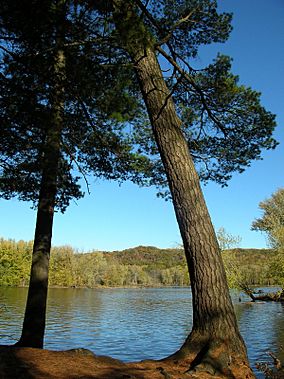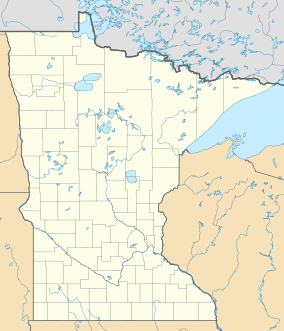William O'Brien State Park facts for kids
Quick facts for kids William O'Brien State Park |
|
|---|---|

The St. Croix River at William O'Brien State Park
|
|
| Location | Washington, Minnesota, United States |
| Area | 1,520 acres (6.2 km2) |
| Elevation | 801 ft (244 m) |
| Established | 1947 |
| Governing body | Minnesota Department of Natural Resources |
William O'Brien State Park is a fantastic place in Minnesota, USA. It's a big park, about 1,520 acres, located right next to the beautiful St. Croix River. You can explore many different areas here, like rolling hills left by glaciers, riverside spots, open grassy areas called oak savannas, thick woods, and even marshy bogs.
It's a favorite spot for lots of outdoor fun! People love to go birdwatching, have picnics, camping under the stars, cross-country skiing in winter, canoeing on the river, and fishing. The park is just a short drive, about two miles, north of a small town called Marine on St. Croix, Minnesota.
Contents
Animals You Might See
William O'Brien State Park is home to many different animals. If you visit, keep an eye out for some of these cool creatures!
Mammals in the Park
You might spot furry friends like raccoons, white-tailed deer, and foxes. Look closely near the water for minks and beavers. You could also see woodchucks digging around.
Birds in the Park
This park is a paradise for birdwatching. Many different kinds of birds live here or visit.
- Raptors and Woodpeckers: You might see powerful raptors flying overhead. Listen for the drumming sound of woodpeckers in the trees.
- Colorful Songbirds: Bright bluebirds and orioles add splashes of color.
- Water Birds: Tall herons can be seen near the river.
- Warblers: A variety of small, active warblers also call this park home.
Park History
The area around the St. Croix River has a long and interesting past.
Early Inhabitants
Long ago, the St. Croix river valley was home to Native American tribes. These included the Dakota and Ojibwe people.
European Settlers and Logging
In the 1600s, European trappers arrived and started trading furs. Later, in the mid-1800s, there was a lot of logging in the area. Loggers mainly cut down tall white pine trees, leaving most other trees untouched.
How the Park Was Created
Once the valuable white pines were gone, the lumber companies sold their land. A wealthy lumber baron named William O'Brien bought much of this land for his own private estate.
After William O'Brien passed away in 1925, his daughter, Alice, made a generous offer. In 1945, she gave 180 acres of land along the river to the state of Minnesota. The state was very happy to accept this gift. At that time, Minnesota didn't have a state park close to the Twin Cities area.
The park was officially created by the state government two years later, in 1947.
Growing the Park
Being close to a big city area was both good and challenging. More land was added to the park whenever possible. This helped reduce crowding and stopped houses from being built right next to the park's edges.
- Greenberg Island: In 1958, a special place called Greenberg Island was donated by S. David Greenberg. He gave it in memory of his parents. You can only reach this island by canoe. It's a peaceful place for wildlife and beautiful wildflowers.
- Expansion and New Campsites: The park also grew to include the bluffs (steep hills) west of Highway 95. A second camping area was added there.
- More Land Added: In 1973, a large piece of land was added, even jumping over a railroad line. Another 120 acres joined the park in 1986.
Today, William O'Brien State Park is still one of the top five most-visited state parks in Minnesota.
Fun Things to Do
William O'Brien State Park offers many ways to enjoy the outdoors.
Boating Adventures
- Canoe Rentals: A company inside the park rents canoes by the hour or for the whole day. They can even shuttle you back from your drop-off points.
- Public Boat Ramp: There's a public place to launch your boat. This part of the Saint Croix National Scenic Riverway is a "slow-speed" zone, which means boats must go slowly. Jetskis are not allowed here.
Camping Options
- Group Camps: Two special group camps are located along the river. They are perfect for tent camping with 35 to 50 people in each.
- Drive-in Camping: You can drive your car or RV right to your campsite. There are two main camping areas: one close to the river and another on top of the bluffs.
- Walk-in Sites: Some campsites on top of the bluff are a short walk (less than 100 yards) from a parking area.
- Camper Cabins: Small, cozy camper cabins are available in the bluff campground. They offer a bit more comfort than a tent, usually with bunk beds and a screened porch. They don't have running water or bathrooms inside, but they are close to campground bathrooms.
Fishing Fun
You can catch different kinds of fish from the St. Croix riverbank. Look for northern pike, walleye, bass, and trout. There's also a special fishing pier near where Lake Alice flows out.
Swimming at Lake Alice
The park has a sandy beach on Lake Alice where you can go swimming. However, swimming is not allowed in the St. Croix River because of strong currents.
Exploring Trails
The park has about 12 miles of trails. These trails are great for hiking and cross-country skiing. Some trails are easy and flat, while others are more challenging with hills.
Images for kids




